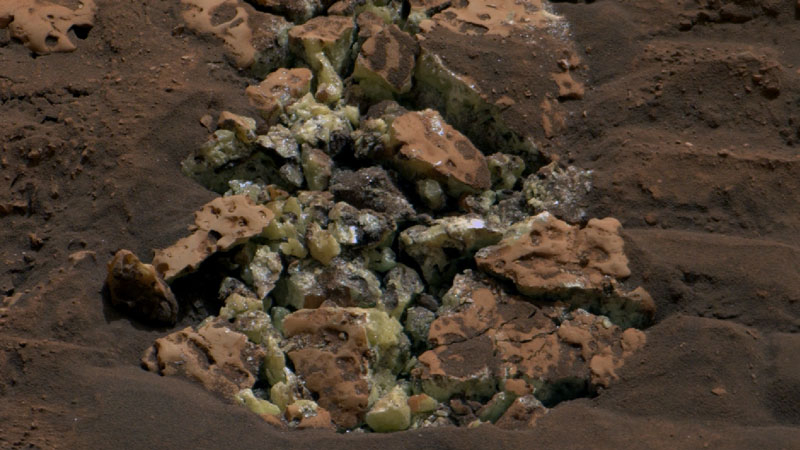NASA rovers have been roaming the expanses of Mars for decades to study its geology and structural features. It would seem that it is difficult to find surprises on the surface of the planet. But Mars was able to surprise scientists. At the end of May this year, NASA’s Curiosity rover discovered many pure sulfur crystals on the surface of the Red Planet. This is a highly unusual find on Mars that has scientists baffled.

Pieces of pure sulfur discovered by Curiosity. Image source: NASA
«Finding a field of stones made of pure sulfur is like finding an oasis in the desert, the scientists explained. “It shouldn’t be there, so now we have to explain it.” Finding strange and unexpected things is what makes planetary exploration so exciting.”
In a sense, sulfur was discovered by accident. With one of its wheels, Curiosity drove over the rocks and crushed the rock, revealing pieces of pure yellow crystalline sulfur. Compounds of sulfur with other minerals, or sulfates, are present in abundance in the rover’s search area. First of all, these are signs of water that once flowed in this area. However, for the formation of pure sulfur there must be a rather narrow range of conditions. Therefore, the discovery has puzzled scientists.
The rover sampled soil near the site where sulfur was discovered, and researchers hope that the analysis performed by its instruments will lead to interesting thoughts. They are not yet ready to speculate on this matter.
Curiosity is currently moving through the Gediz Wallis Channel. This channel on the slope of Mount Sharp, to the base of which the rover has been climbing since 2014, was discovered from space long before Curiosity arrived on Mars. It is believed that it could have been cut through by water flowing from above in the Gediz Vallis ridge. There are many boulders in the canal, both brought by water (they are of the highest value to scientists) and those that rolled down during the process of natural destruction of rocks or landslides. Stones brought by water can be easily distinguished from stones that have rolled down their rounded sides, polished in the flowing stream.
By moving up to the base of the mountain, the rover is able to search for traces of ancient life on Mars, layer by layer – epoch by epoch. Curiosity will never find the microbes themselves, but it is quite capable of recognizing potentially suitable conditions for their life, nutrition and reproduction. At the same time, there is always room for a celebration of discoveries using the example of pure sulfur discovered on May 30, 2024 on Mars. Unexpected discoveries are always a holiday for scientists, which promise unexpected breakthroughs and discoveries.